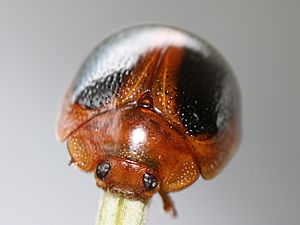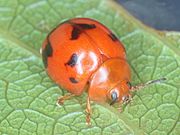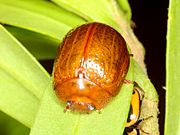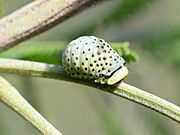Dicranosterna facts for kids
Quick facts for kids Dicranosterna |
|
|---|---|
 |
|
| Dicranosterna immaculata | |
| Scientific classification | |
| Kingdom: | |
| Phylum: | |
| Class: | |
| Order: | |
| Family: | |
| Subfamily: |
Chrysomelinae
|
| Genus: |
Dicranosterna
Motschulsky, 1860
|
| Species | |
See text for complete list |
|
Dicranosterna is a special group, or genus, of leaf beetles. These beetles belong to a larger family called Chrysomelidae. They are known for their unique shapes and where they live.
These beetles have a rounded, dome-like shape, a bit like half a sphere. Their young, called larvae, are also round, like tiny balls. The hard wing covers, called elytra, have many small dents or "punctures" on them. These dents are scattered and not in neat lines.
There are 36 different kinds, or species, of Dicranosterna beetles. You can find all of them living only in Australia. This means they are "endemic" to Australia, which means they naturally live nowhere else in the world.
These beetles mostly eat plants from the Acacia family. Scientists once thought they ate Eucalyptus plants too, but later research showed this was not correct. The larvae of these beetles are round and have tiny hairs that are hard to see. They also have special glands on their backs and don't have certain leg-like parts at their rear end.
Contents
Discovering Dicranosterna Beetles
Have you ever wondered about the amazing insects around us? Dicranosterna beetles are a fascinating group of creatures. They are a type of leaf beetle, which means they spend their lives munching on leaves.
What Do Dicranosterna Beetles Look Like?
These beetles have a very distinct look. Imagine a tiny, shiny dome – that's often what an adult Dicranosterna beetle looks like! They are described as "hemispherical," meaning they are shaped like half a sphere. Their larvae, the young beetles, are also round, like little spheres.
The hard outer wings of the beetle are called elytra. If you look closely, you'd see that these wings have many small pits or dents. These pits are called "punctures." Unlike some beetles where these punctures form neat rows, on Dicranosterna beetles, they are scattered and not lined up.
Where Do Dicranosterna Beetles Live?
All 36 known species of Dicranosterna beetles live only in Australia. This makes them "endemic" to Australia. It means you won't find them naturally anywhere else in the world! They are a unique part of Australia's amazing wildlife.
These beetles mainly feed on Acacia plants. Acacia trees and shrubs are very common in Australia. The beetles rely on these plants for their food.
The Life of a Dicranosterna Larva
The larvae of Dicranosterna beetles are quite interesting. They are round, like little balls, and have tiny hairs that are hard to see without a magnifying glass. They also have special glands on their backs. These glands might help them protect themselves. Unlike some other insect larvae, they don't have certain leg-like parts at their rear end.
Gallery
All the Dicranosterna Species
There are many different kinds of Dicranosterna beetles. Here is a list of all the known species:
- Dicranosterna abdominalis Chapuis, 1877
- Dicranosterna aeraria (Chapuis, 1877)]]
- Dicranosterna alessandrae (Daccordi, 2005)
- Dicranosterna bicolor (Daccordi, 2003)
- Dicranosterna bipuncticollis (Chapuis, 1877)
- Dicranosterna circe (Stål, 1860)
- Dicranosterna coccinelloides (Olivier, 1807)
- Dicranosterna contracta (Chapuis, 1877)
- Dicranosterna foraminosa (Chapuis, 1877)
- Dicranosterna globata (Chapuis, 1877)
- Dicranosterna globulosa (Chapuis, 1877)
- Dicranosterna hastata (Chapuis, 1877)
- Dicranosterna hemisphaerica (Chapuis, 1877)
- Dicranosterna immaculata (Marsham, 1808)
- Dicranosterna lateralis (Blackburn, 1893)
- Dicranosterna limbata (Weise, 1917)
- Dicranosterna mimulav (Blackburn, 1890)
- Dicranosterna ngarinmana (Daccordi, 2003)
- Dicranosterna nigrosuturalis (Lea, 1924)
- Dicranosterna novemlineata (Lea, 1924)
- Dicranosterna oblonga (Chapuis, 1877)
- Dicranosterna palmensis (Blackburn, 1896)
- Dicranosterna picea (Olivier, 1807)
- Dicranosterna prolixa (Weise, 1917)
- Dicranosterna rubeola (Chapuis, 1877)
- Dicranosterna ruffoi Daccordi, 2003
- Dicranosterna selene (Blackburn, 1901)
- Dicranosterna semipunctata (Chapuis, 1877)
- Dicranosterna septentrionalis (Weise, 1917)
- Dicranosterna stali (Chapuis, 1877)
- Dicranosterna subaeraria (Lea, 1924)
- Dicranosterna subovalis (Chapuis, 1877)
- Dicranosterna trimorpha (Lea, 1924)
- Dicranosterna umbrata (Chapuis, 1877)
- Dicranosterna valica Daccordi, 2003
- Dicranosterna vexabilis Weise, 1917




